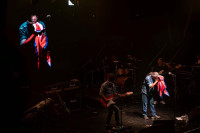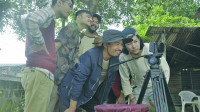Entertainment
The art of affairs
Mahesh, Anil and Devashish had to re-evaluate their decade long friendship in the events triggered after Anil, the most affluent of the three, buys a contemporary painting and a very expensive one at that, much to the disdain of these two friends.
Asmita Manandhar
Mahesh, Anil and Devashish had to re-evaluate their decade long friendship in the events triggered after Anil, the most affluent of the three, buys a contemporary painting and a very expensive one at that, much to the disdain of these two friends. The conflict between Mahesh and Anil escalates to such a level that they come down to violent confrontation, with Dev trying unsuccessfully to diffuse the situation and at the end himself taking a blow.
Director Sabine Lehmann’s interpretation of critically acclaimed play Art by Yasmina Reza masterfully interrogates the long suppressed anger, fear, disappointments and insults among the three men, each trying to rope themselves, through various means to the top tier of the social structure. The three lead—Mahesh played by Karma, Anil played by Raymon Das Shrestha and Devashish played by Kundoon— exude life to their characters with their energetic presence throughout the two hours performance.
Like many of Lehmann’s productions, the stage is simple yet colourful while the characters are muted in black, white and black and white stripes for Mahesh, Anil and Dev respectively, each signifying their personality and assertiveness. Karma and Raymon, from their opening sequence, immediately grab the audience’s attention. Both embody their character’s essence completely, quickly establishing the tone and layers within the narrative. But it’s Kundoon who outshines both the seasoned actors. His presence brings a much needed adhesive between the two characters and his expressions are as remarkable as his dialogue delivery. The sequence where he unexpectedly bursts into a rap is as amusing to say the least.

The actors constantly break the fourth wall and speak to the audience directly. But it also seems as though they are not talking to the audience but rather to themselves. It is their inner voice that represents their true feelings but as they are engaged in a head-butt, they are just voicing their thoughts to themselves. This cleverly adds to the story development as well as audience’s interpretation.
The play is so fast-paced and tightly composed that even the movement of the actors as they set the transition between the scenes looks like a choreographed sequence. The actors themselves set the stage in the dim light for successive scenes like dragging the paintings or rearranging the couch. The presence of only three silhouette figures on the stage, as if resisting any infiltration, helps to build the suspense.
Apart from the three actors, it is only music that permeates through the stage with the beautiful arrangement of Aman Karna accompanied by Prince Nepali’s Sarangi. The music in the background is so beautifully crafted that it occasionally moves to the foreground, with a character of its own. Lehmann’s affection for plain yet structured choreography willfully accommodates the music, giving the audience a wonderful amalgamation of senses.
Lehmann and set designer Ludmilla Hungerhuber also make a cameo appearance in the background. As they break into a comical melody, they recount the ridiculousness of the three character’s outlook of the situation, calling them ‘boys’, a nod to other men in authority as well, mainly the world leaders in the current scenario.
The play is a relatable representation of growing or outgrowing of human relationships, and its never-ending journey. It is funny, poignant and also thought evoking at the same time, inviting audiences to its own world.
The play is staged at Hotel Vajra in the capital, three days a week until December 30.




 20.12°C Kathmandu
20.12°C Kathmandu.jpg)










